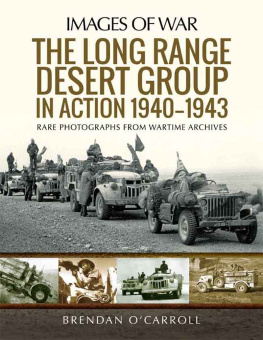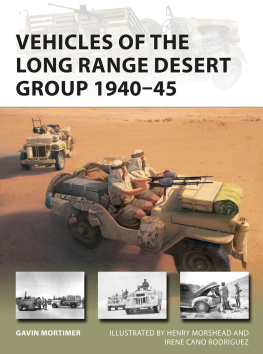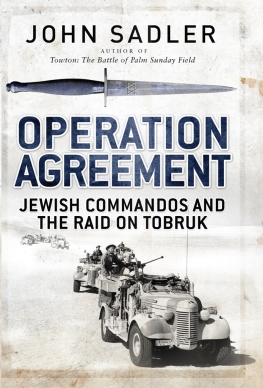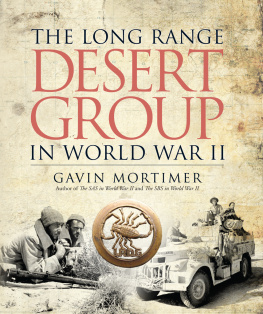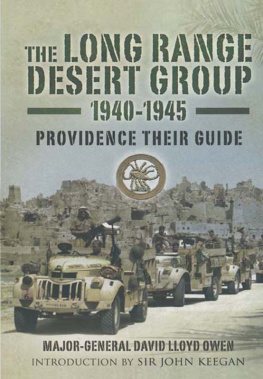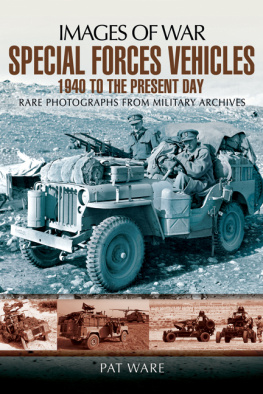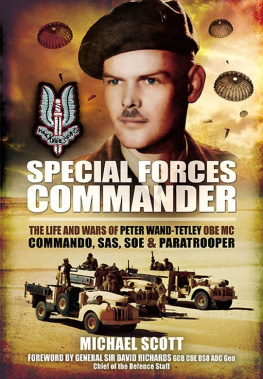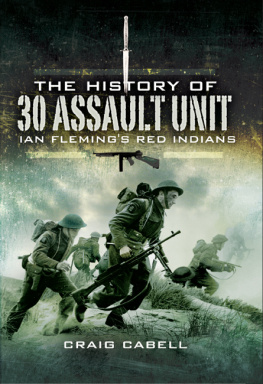Pagebreaks of the print version

IMAGES OF WAR
THE LONG RANGE DESERT GROUP IN ACTION 19401943
RARE PHOTOGRAPHS FROM WARTIME ARCHIVES
Brendan OCarroll
First published in Great Britain in 2020 by
PEN & SWORD MILITARY
An imprint of
Pen & Sword Books Ltd
Yorkshire Philadelphia
Copyright Brendan OCarroll, 2020
ISBN 978-1-52677-741-6
eISBN 978-1-52677-742-3
Mobi ISBN 978-1-52677-743-0
The right of Brendan OCarroll to be identified as author of this work has been asserted by him in accordance with the Copyright, Designs and Patents Act 1988.
A CIP catalogue record for this book is available from the British Library.
All rights reserved. No part of this book may be reproduced or transmitted in any form or by any means, electronic or mechanical including photocopying, recording or by any information storage and retrieval system, without permission from the Publisher in writing.
Pen & Sword Books Limited incorporates the imprints of Atlas, Archaeology, Aviation, Discovery, Family History, Fiction, History, Maritime, Military, Military Classics, Politics, Select, Transport, True Crime, Air World, Frontline Publishing, Leo Cooper, Remember When, Seaforth Publishing, The Praetorian Press, Wharncliffe Local History, Wharncliffe Transport, Wharncliffe True Crime and White Owl.
For a complete list of Pen & Sword titles please contact
PEN & SWORD BOOKS LIMITED
47 Church Street, Barnsley, South Yorkshire, S70 2AS, England
E-mail:
Website: www.pen-and-sword.co.uk
or
PEN AND SWORD BOOKS
1950 Lawrence Rd, Havertown, PA 19083, USA
E-mail:
Website: www.penandswordbooks.com
Acknowledgements
T his book would not exist if it were not for the kindness and generosity of a number of like-minded military historians, veterans and their families, researchers, collectors and authors who shared their research material and photos. Listed further are the names of the many who contributed to help create this photographic tribute to the Long Range Desert Group.
I wish to thank Jonathan Pittaway of South Africa, the author of two books on the LRDG: LRDG Rhodesia (2002) and Long Range Desert Group, Rhodesia: The Men Speak (2009). He has kindly shared the Rhodesian S Patrol images published in this book and has been very supportive of my publications over the years.
Also thanks to Ian Chard from England, LRDG researcher and Y Patrol historian. He has been a wonderful contributor, providing copies of LRDG photos and other related research documents from British LRDG veterans. The Y Patrol images, via Ian, came from the wartime albums of Brian and Marjorie Springford, Harry Chard, Tich Cave and Mick Allen. Ian was always helpful and very responsive in answering my many queries or offering information.
Thanks to my wife Margaret for her kind assistance and patience with logistics and proofreading skills, and to my children, Diana, Michelle and Patrick, for their continued support with resolving computer processes and technical issues, photography and general advice.
Thanks to my photo restorer Nick Hofmann for his skill, time and patience in enhancing up some of the poorer images, as civilian wartime film developing in dirty Cairo water had left much dust, dirt and fluff on the original personal album photographs.
A special acknowledgement goes to the New Zealand LRDG veterans, listed below, who over my twenty years of research kindly shared their memories with me; also in allowing me generous access to their private wartime photograph albums, along with permission to publish the images as a tribute to their LRDG comrades. All of these men have now passed on, but their stories remain in image and word.
The veterans include Denis Bassett, Merlyn Craw, Merv Curtis, Merle Fogden, Les Nicholls, Peter Garland, Buster Gibb, Ian Gold, Ray and Erl Gorringe, Basil Green-street, Don Gregory, Jack Job, Ian Judge, Fred Kendall, Dick Lewis, Sam Lucas, Charles McConachie, Ian McCulloch, Peter McGregor, Les Middlebrook, Tom Ritchie, Alf Saunders, Keith Tippett, Richard Williams, Wally Rail, Clarke Waetford, Bill Whimp, Frank White, Bill Willcox, Alex Yaxley.
Finally, my thanks to the many other contributors, including fellow researchers and LRDG widows and family members, who also provided photos and reference material, along with their time and interest. Furthermore, I apologize to any I may have overlooked, as over my many years of writing the names of some individual contributors may have been lost. I have made my best efforts to include all, and to acknowledge their support in sharing images, permissions, etc. Without the help of so many people, it would have been impossible to present this visual record of the LRDG adequately. Thanks to the following: Peter and Rosemary Beech, Ricardo Brennan, Leighton Burne, Bain and Dorothy Cross, David Ellis, the Fogden family, Amanda Gill, Andrew Honeyfield, Jenny Hughes, Ken Johnson, Irene Jopling, John Leonard, Ngaire Lewis, Jason and Nik Magerkorth, Liz McNeil, Ethan OCarroll, Sharon Palmer, Shirley Patten, Matthew Rice, Antonio Maraziti, Jeremy Riley, Bill Saxton, Eric, John and Michael Shepherd, Lucie Stokes, Emily Subritzky, Isabelle Subritzky, Nick Szalardi, David Thompson, John (Jack) Valenti, Charlie Waetford, Warner Wilder, Eric Wilson and Ronny Yavin.
Introduction
T his is an overview tale of the Long Range Desert Group (LRDG) told through images and explanatory captions. The journey through wartime photos starts with its formation in July 1940 until the end of 1943, after which the unit was re-established and transformed into a Commando-type role serving in Europe until the end of the war.
It is set out introducing the founding unit in the early days, the Long Range Patrol (LRP). From there it progresses to the formation of the Long Range Desert Group and their first significant behind-the-lines operation in the Fezzan region, southern Libya. The next chapters cover the vehicles, weapons, equipment and activities from when the specially desert-adapted CMP Fords and 1942 Chevrolets were used, between 1941 and 1943. The LRDG Air Section is also presented. The famed Barce Raid in September 1942 is described in a photo narrative and from there follows a pictorial overview of the closing days in the desert. The Dodecanese operations in the Aegean in late 1943 embody the final images.
The story is told in the chapter introductions and captions and begins with the units initial purpose of travelling long distances behind enemy lines in Libya on intelligence-gathering, mapping and reconnaissance missions; hence they were first known as the Long Range Patrols, manned by New Zealanders and British officers. In December 1940 the British Guards joined and it then became the Long Range Desert Group. Soon after, they were reinforced by troops from Southern Rhodesia and British Yeomanry regiments who formed their own individual patrols.
This work is not intended to be a concise history of the LRDG as many other publications have already provided that. Rather the images are presented to serve as a general reference to the type of vehicles used, including the weapons and equipment, the sort of aircraft they flew, the landscape travelled, some personalities and uniform and insignia. There are also views of enemy action, results of LRDG-placed ambushes, the taking of prisoners, attacks on airfields and forts and working with the SAS.

